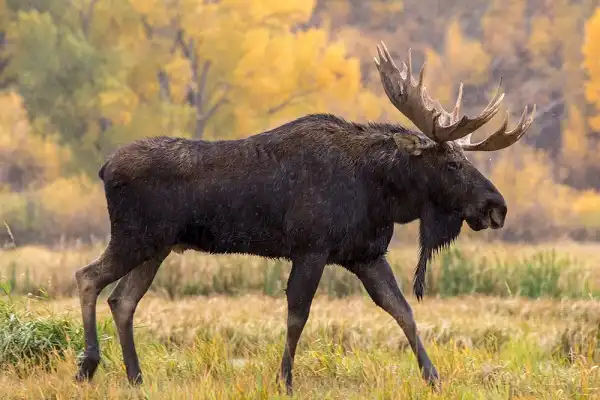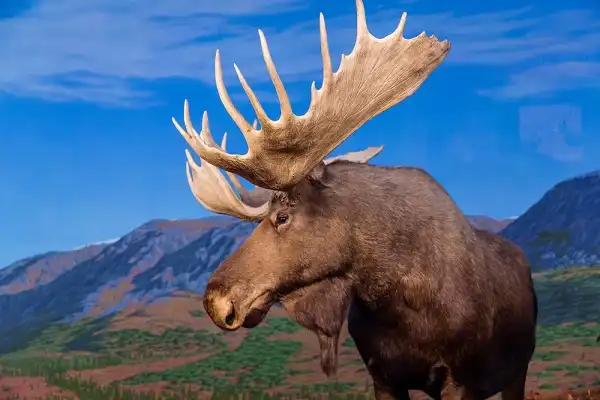Moose are an iconic symbol of the North American wilderness and make up a crucial part of the animal kingdom’s biodiversity. With their iconic antlers, towering stature, and impressive agility in the water and on land, moose have long been admired for their strength and adaptability. Despite this admiration for these animals, however, few people know about the ecology behind this fascinating species or understand how important it is to conserve them for future generations. In this blog post, we’ll explore several aspects of moose biology — from anatomy to behavior — that can illuminate why conservation efforts are so necessary. So if you want to learn more about one of nature’s most majestic creatures, read on!

Moose Description
Moose, also known as elk in Europe, is the largest of the deer family and are native to North America, Europe, and Asia. They are easily recognizable thanks to their impressive antlers. But these animals are more than just a pretty sight; they have an incredibly complex physiology and lifestyle. Their unique physical adaptations, including an elongated nose, large lungs, webbed toes, and water-resistant fur, allow them to stay submerged for a long time while crossing rivers, ponds, and lakes. This makes it easier for them to escape from predators, search for food on the opposite side of a river, or expand their territory. A moose’s body is perfectly adapted to its environment. Its large, elongated nose helps to warm and humidify inhaled air, making it easier to breathe in the cold, harsh climate of the north. Similarly, their thick fur allows them to remain warm in colder temperatures, protecting them from the winter elements.
Moose Habitat
Moose are found across a wide range of habitats in the Northern Hemisphere, including boreal forests, subarctic forests, and tundra regions. In North America, they are most commonly found in Alaska, Canada, and the northern United States, while in Europe, they inhabit northern regions such as Scandinavia and the Baltic States. Within their habitats, moose have specific requirements for food, shelter, and breeding. They are most commonly found near water sources, such as rivers, lakes, and wetlands, where they can forage on aquatic plants like water lilies, pondweed, and arrowhead. Moose also prefer thick forests with an abundance of deciduous trees, such as aspen and willow, as well as evergreens like spruce and pine. Moose rely heavily on dense vegetation for cover and protection, and will often bed down in areas with thick underbrush or fallen trees. Because of their specific habitat needs and the pressures of human development, many moose populations have been impacted by habitat loss and fragmentation. In addition to being displaced by roads, buildings, and other infrastructure, moose are also vulnerable to environmental factors like climate change, which can alter the availability and quality of food and habitat.
Moose Diet
Moose are impressive animals that have unique dietary needs to maintain their large and robust bodies. As herbivores, they rely heavily on plant matter for sustenance. In particular, moose primarily consume aquatic plants during the summer months, such as water lilies, pondweed, and cattails, which are rich in nutrients and provide ample hydration. Moose are also known to eat a variety of woody browse throughout the year, including tree saplings, shrubs, and twigs from understory vegetation. Deciduous trees like willows and aspens are a favorite of these large mammals, as they are abundant in many moose habitats and provide a significant amount of nutrients, including protein, minerals, and vitamins. During the winter months, when food sources are scarce, moose will strip the bark from the same deciduous trees that they consume during the summer. This behavior, known as winter bark stripping, provides moose with a crucial source of nutrition and helps them survive harsh winter conditions. Despite their ability to digest and extract nutrients from their primary food sources, which are often low in nutrients and high in fiber, moose require a significant amount of food per day to maintain their large bodies. In fact, an adult moose can consume up to 60 pounds of food per day.

Moose Size
Moose is one of the largest members of the deer family, known for their massive size and impressive antlers. Adult moose can weigh between 800 to 1500 pounds and stand at an impressive height of up to 7 feet at the shoulder. Males, or bulls as they are commonly referred to, are typically larger than females or cows. Bulls can weigh up to 1500 pounds and have antlers that can span up to 6 feet, making them one of the most recognizable and impressive animals in North America. Females, on the other hand, are smaller than males, weighing in at an average of 800 pounds. Female moose do not have antlers, but they do have a distinct hump on their backs, which provides extra strength to support their massive bodies.
Moose Lifespan
Moose, with their massive size and unique adaptations, have a lifespan that is contingent upon a variety of factors, including habitat, nutrition, and predation. On average, moose can live anywhere from 15 to 25 years, although this can vary depending on their environment. One of the primary factors that can impact moose lifespan is the availability of food sources. As herbivores, moose require large amounts of plant matter to fuel their bodies, and a lack of food can lead to malnutrition, illness, and death. Furthermore, a decrease in food availability may lead moose to consume less nutritious plant materials, which can also impact their health and lifespan. Predation is another factor that can impact moose lifespan. Although moose are large and formidable animals, they are still vulnerable to predation from wolves, bears, and other carnivores. In areas where predation is high, moose may have a shorter lifespan as they are more likely to be killed by predators. Environmental factors, such as climate and habitat loss, can also impact moose lifespan. As climate change alters the timing of seasonal changes, moose may struggle to find food sources, which can impact their overall health and well-being. Habitat loss due to human development can also result in a decrease in moose populations, as their natural habitats are destroyed or fragmented.
Moose Behavior
Moose are not only fascinating for their physical characteristics and impressive size, but also for their unique behaviors. These magnificent creatures are known for being solitary animals, except during the mating season, when they seek out mates and form small groups. During the summer months, moose can be seen foraging for food in open meadows and along riverbanks. They are primarily herbivores, feeding on a variety of plants such as willows, birch, and aquatic plants. Moose have an interesting digestive system that allows them to extract essential nutrients from their plant-based diet. They are known for regurgitating and re-chewing their food before it moves to the small intestine for final processing. In the winter months, moose often travel in search of food, navigating through deep snow and dense forests. They may also retreat to denser forests for shelter during the harsh winter weather. During this time, they rely on their thick hair and fat layer to keep warm, and they conserve energy by being more sluggish. When threatened, moose are known to be aggressive and can charge at predators or humans if they feel threatened. Their long legs enable them to run at high speeds making them difficult to outrun. However, they generally avoid confrontations and will only attack if they feel that their lives are in danger.
Moose Speed
Moose are fascinating creatures that possess several unique physical characteristics, such as their massive bulk and signature antlers. However, their impressive size and weight do not hinder their ability to move swiftly through their natural habitats. Moose are surprisingly agile and can run at impressive speeds of up to 35 mph, making them one of the fastest animals in North America. Moose’s speed is not limited to their running alone. In water, they are equally impressive, being excellent swimmers, even in deep or fast-flowing rivers. Predators in moose habitats, such as wolves, bears, and mountain lions, are aware of the moose’s impressive speed and agility, and often avoid them altogether, choosing easier prey. Contrary to their intimidating appearance, moose are generally peaceful animals, except when threatened. They will only attack if they feel that their lives or young are in danger, usually as a defense mechanism.

Moose Hunting
Although hunting moose is legal in some parts of the world, it is important to note that moose populations are vulnerable to overhunting. To ensure that their numbers are sustainably managed, most countries have specific hunting seasons and quotas that limit the number of moose that can be hunted in a given year. Moose hunting is often a popular outdoor recreational activity among hunters, as their meat is considered a delicacy and their antlers are highly prized for their ornamental value. When hunting moose, hunters typically use rifles or bows and arrows to take down their prey. However, it is important to have proper training and licensing before embarking on a moose-hunting expedition. Hunting moose can be a challenging and dangerous endeavor as they are formidable animals. In addition to their impressive speed and agility, they also possess sharp hooves and antlers that can be lethal if they charge at their hunters. As such, hunters must exercise caution and follow strict safety protocols when hunting moose to prevent accidents and injuries.
Moose Communication
In addition to their impressive physical features and abilities, moose also possess a wide range of communication tools. These vocalizations are used to communicate within the species, as well as with other animals in their environment. Moose typically communicate through a variety of sounds such as calls, grunts, and squeaks. The purpose of these vocalizations can range from expressing alarm or aggression to alerting others of nearby predators or indicating that the animal is ready to mate. Depending on the context and location, moose will often adjust the volume and type of sound they produce accordingly. Moreover, male moose is known for producing distinctive “bull-like” bellows during mating season which can be heard from miles away.
Moose Reproduction
When it comes to reproduction, moose have a unique mating system. Bulls in their prime typically compete fiercely for the attention of receptive cows and will engage in “rutting” behavior which involves bellowing loudly and lashing out at competitors with their antlers. After mating is complete, female moose typically remain pregnant for an average of 7-8 months before giving birth to 1-2 calves. The mother will often stay near her young for several weeks after they are born before leaving them on their own. The calves usually reach maturity within 2-3 years.

Conclusion
Moose are an iconic species that inhabit many parts of the world, with their majestic antlers and impressive physical features. Their remarkable speed and agility allow them to navigate through any terrain easily, while their powerful muscles and swimming skills enable them to cross rivers and other bodies of water with ease. Moreover, they possess sharp hooves and antlers that can be dangerous if provoked, making them one of the toughest animals in the animal kingdom. It is important for us to ensure that moose populations remain healthy by practicing selective hunting and meat harvesting when appropriate, as well as educating ourselves about the importance of conserving their habitats.
Frequently Asked Question

